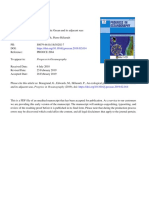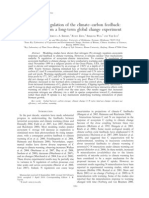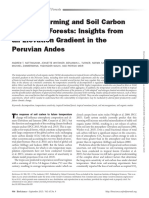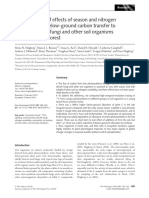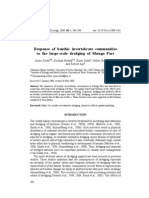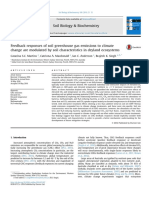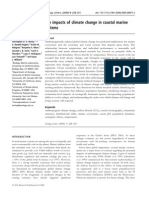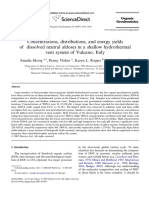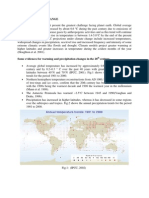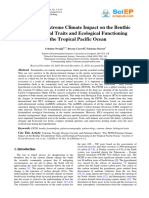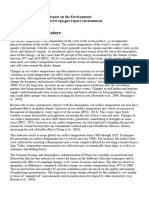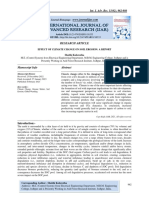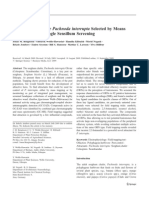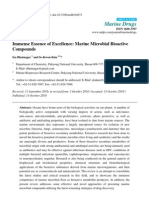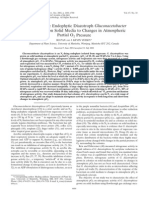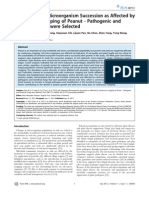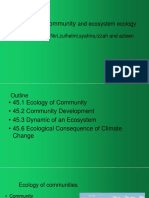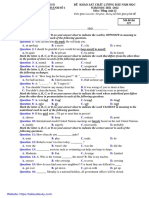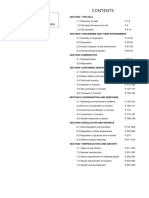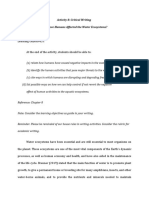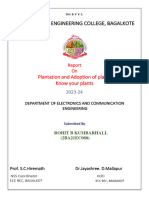Shifts in Soil Microorganisms in Response To Warming Are Consistent Across A Range of Antarctic Environments
Shifts in Soil Microorganisms in Response To Warming Are Consistent Across A Range of Antarctic Environments
Uploaded by
10sgCopyright:
Available Formats
Shifts in Soil Microorganisms in Response To Warming Are Consistent Across A Range of Antarctic Environments
Shifts in Soil Microorganisms in Response To Warming Are Consistent Across A Range of Antarctic Environments
Uploaded by
10sgOriginal Description:
Original Title
Copyright
Available Formats
Share this document
Did you find this document useful?
Is this content inappropriate?
Copyright:
Available Formats
Shifts in Soil Microorganisms in Response To Warming Are Consistent Across A Range of Antarctic Environments
Shifts in Soil Microorganisms in Response To Warming Are Consistent Across A Range of Antarctic Environments
Uploaded by
10sgCopyright:
Available Formats
The ISME Journal (2012) 6, 692702
& 2012 International Society for Microbial Ecology All rights reserved 1751-7362/12 www.nature.com/ismej
ORIGINAL ARTICLE
Shifts in soil microorganisms in response to warming are consistent across a range of Antarctic environments
Etienne Yergeau1,2, Stef Bokhorst3, Sanghoon Kang4, Jizhong Zhou4, Charles W Greer2, Rien Aerts5 and George A Kowalchuk1,5
1
Department of Microbial Ecology, Netherlands Institute of Ecology, Wageningen, The Netherlands; 2National Research Council of Canada, Biotechnology Research Institute, Montreal, QC, Canada; 3Department of Forest , Sweden; 4Department of Ecology and Management, Swedish University of Agricultural Sciences, Umea Botany and Microbiology, Institute for Environmental Genomics, University of Oklahoma, Norman, OK, USA and 5Department of Systems Ecology, Institute of Ecological Science, VU University Amsterdam, Amsterdam, The Netherlands
Because of severe abiotic limitations, Antarctic soils represent simplified systems, where microorganisms are the principal drivers of nutrient cycling. This relative simplicity makes these ecosystems particularly vulnerable to perturbations, like global warming, and the Antarctic Peninsula is among the most rapidly warming regions on the planet. However, the consequences of the ongoing warming of Antarctica on microorganisms and the processes they mediate are unknown. Here, using 16S rRNA gene pyrosequencing and qPCR, we report highly consistent responses in microbial communities across disparate sub-Antarctic and Antarctic environments in response to 3 years of experimental field warming ( 0.5 to 2 1C). Specifically, we found significant increases in the abundance of fungi and bacteria and in the Alphaproteobacteria-to-Acidobacteria ratio, which could result in an increase in soil respiration. Furthermore, shifts toward generalist bacterial communities following warming weakened the linkage between the bacterial taxonomic and functional richness. GeoChip microarray analyses also revealed significant warming effects on functional communities, specifically in the N-cycling microorganisms. Our results demonstrate that soil microorganisms across a range of sub-Antarctic and Antarctic environments can respond consistently and rapidly to increasing temperatures. The ISME Journal (2012) 6, 692702; doi:10.1038/ismej.2011.124; published online 22 September 2011 Subject Category: microbial ecosystem impacts Keywords: Antarctica; carbon cycle; GeoChip microarrays; global warming; nitrogen cycle; open-top
chambers
Introduction
The Antarctic Peninsula is among the most rapidly warming regions on the planet (Steig et al., 2009). However, Antarctica is still the coldest, windiest, driest and most isolated continent on Earth. Consequently, Antarctic terrestrial food webs are relatively simple, being characterized by the general absence of insect and mammalian herbivores. In the relative absence of grazing, most energy and biomass is channeled into a detritus trophic pathway (Davis, 1981), which is dominated by microbial activities. Thus, soil microorganisms have a disproportionate
Correspondence: E Yergeau, Environmental Microbiology, National Research Council of Canada, Biotechnology Research Institute, 6100 Royalmount Avenue, Montreal, QC H4P 2R2, Canada. E-mail: Etienne.Yergeau@cnrc-nrc.gc.ca Received 30 May 2011; revised 1 August 2011; accepted 1 August 2011; published online 22 September 2011
importance in nutrient cycling and other ecosystem processes in ice-free terrestrial ecosystems in the Antarctic. In spite of the importance of microorganisms in Antarctic soils and the rapid warming of the Antarctic Peninsula, very little is known about how these microbial communities respond to global warming. Some insight has been gained by comparing microbial communities across an Antarctic latitudinal gradient, as a proxy for long-term climatic trends (Yergeau et al., 2007ac, 2009), or via short-term laboratory incubations (Yergeau and Kowalchuk, 2008). The few field studies reported to date have shown modest effects of warming on soil organic matter decomposition, as well as other soil processes and bacterial temperature sensitivity (Treonis et al., 2002; Bokhorst et al., 2007a; Rinnan et al., 2009). Based on this limited evidence, it was hypothesized, that the responses of Antarctic soils will be overridden by nutrient or water limitations
Antarctic soil microbes and warming E Yergeau et al 693
(Wynn-Williams, 1996; Treonis et al., 2002; Wasley et al., 2006), similar to what is observed in Arctic soils (Ruess et al., 1999; Rinnan et al., 2007). However, rapid responses of mosses, nematodes, soil algae and cyanobacteria have been observed in some Antarctic soils (Kennedy, 1996; Wynn-Williams, 1996; Convey and Wynn-Williams, 2002). Currently, there is a clear gap in knowledge related to the underlying responses of key microbial parameters, like diversity, community composition, abundance and C- and N-cycle functions, to global warming. Given the central roles of microorganisms in Antarctic soil nutrient cycling, this knowledge is crucial to predicting the trajectory of Antarctic terrestrial environments following global warming. Our objective was, therefore, to examine the impact of short-term, environmentally relevant field warming on sub-Antarctic and Antarctic soil microbial community composition, diversity, abundance and functions. We conducted in situ warming experiments for 3 years using open-top chambers (OTCs) at one sub-Antarctic (Falkland Islands, 521S) and two Antarctic locations (Signy and Anchorage Islands, 601S and 671S, respectively) (see Supplementary Figure S1 for a map). At each location, we compared OTC plots with adjacent control plots in both densely vegetated and bare fell-field environments for a total of 12 treatments. Pyrosequencing (454 GS FLX Titanium, Roche Diagnostics, Laval, QC, Canada) of 16S rRNA gene amplicons was used to follow bacterial diversity and community composition, and functional gene microarrays (GeoChip 2.0; He et al., 2007) were used to assess changes in functional gene distribution. Although the sampled soil environments were highly disparate, experimental warming through OTC manipulation induced a number of consistent changes in microbial communities across all the sampling sites, including decreases in the relative abundance of Acidobacteria, increases in the relative abundance of Alphaproteobacteria and weakened correlation between taxonomical and functional richness.
differences in C and N inputs to soils (Yergeau et al., 2007a). The dominant species in these plots at the start of the experiment were as follows: Falkland vegetated: Empetrum rubrum (vascular plant, mean cover 68%); Falkland fell-field: Poa annua (vascular plant, 26%); Signy-vegetated: Chorisodontium aciphyllum (moss, 76%); Signy fell-field: Usnea antarctica (lichen, 53%); Anchorage vegetated: Sanionia uncinata (moss, 48%); Anchorage fellfield: Buellia latemarginata (lichen, 30%) (Bokhorst et al., 2007b). No significant changes in the vegetation composition and diversity of all sites were observed after 2 years of warming (Bokhorst et al., 2007b). Vegetation composition and diversity were not measured after 3 years of warming. Table 1 summarizes soil characteristics as measured in the experimental plots. Additional soil characteristics are described by Bokhorst et al. (2007a) and Yergeau et al. (2007a).
Experimental design
Materials and methods
Site descriptions
One sub-Antarctic site and two Antarctic sites were chosen at the following locations: Falklands Islands (sub-Antarctic zone; 511760 S 591030 W), Signy Island (South Orkney Islands, maritime Antarctic; 601430 S, 451380 W) and Anchorage Island (near Rothera Research station, western Antarctic Peninsula; 671340 S, 681080 W). At each location, two types of environments were selected: (1) vegetated, where dense vegetation cover was present with retention of underlying soil and (2) fell-field, represented as rocky or gravel terrain with scarce vegetation or cryptogam coverage, for a total of six contrasting environments. Densely vegetated and bare environments represent two contrasting environments for Antarctic soil microorganisms, with large
The experiment was established during the 2003 2004 austral summer. The design consisted of 12 paired 2 2 m plots per environment. Half the plots were covered with standard-type OTC, warming underlying plants and soils passively (see Marion et al., 1997 for further details), while the other half served as control plots. The Falkland Islands fellfield habitat was not sufficiently extensive at the study site to allow for such a design, and only 6 plots (3 OTCs and 3 controls) were delineated in this environment. The remaining OTCs and controls were placed in the vegetated environment, resulting into 18 Falkland Islands vegetated plots (9 OTCs and 9 controls). Soil moisture and temperature were monitored hourly, along with wind speed and direction, photosynthetically active radiation and precipitation. OTCs at our sampling sites passively increased annual soil temperature by B0.8 1C at a soil depth of 5 cm (Bokhorst et al., 2007a). This increase was, however, not constant throughout the year, and varied between the different locations sampled (Bokhorst et al., 2007a). Warming in Antarctica is expected to not only increase average temperatures, but also reduce the frequency of freeze-thaw events, and our OTC treatments mimicked this scenario for the Antarctic environments studied (Table 1). Detailed trends in temperature and other environmental factors modified by the OTCs are provided by Bokhorst et al. (2007a). It must be noted that OTCs can affect numerous environmental variables besides temperature including wind speed, snow cover and relative humidity, although previous studies have estimated that these unwanted effects are generally small (Marion et al., 1997; Hollister and Webber, 2000). Among the unwanted effects that could have affected our results more strongly are prolonged snow accumulation in spring, delay in soil thaw in spring and occurrence of extreme temperatures in summer (Bokhorst et al., 2011).
The ISME Journal
Antarctic soil microbes and warming E Yergeau et al 694
Table 1 Mean summer soil temperature (at a 5-cm depth), soil freeze-thaw cycles (FTCs), soil moisture, extractable soil nitrogen content and soil respiration for control and OTC plots at the Falkland, Signy and Anchorage Islands on vegetated and fell-field sites
Summer mean soil T (1C) Falkland Islands Vegetated Control OTC Fell-field Control OTC Signy Island Vegetated Control OTC Fell-field Control OTC Anchorage Island Vegetated Control OTC Fell-field Control OTC FTC (year -1) Soil moisture (%) NH+ 4 (mg kg1) NO 3 (mg kg1) %N Resp. (mg CO2 m2 h1)
10.7 (0.3) 10.7 (0.5) 11.0 (0.3) 11.7 (0.1)
0.3 (0.6) 1.7 (2.1) 12.3 (14.6) 13.7 (22.0)
0.27 (0.05) 0.20 (0.09) NA NA
24.5 (13.5) 21.6 (8.5) 15.7 (9.9) 19.3 (12.6)
0.8 (0.6) 1.0 (0.6) 23.5 (6.8) 48.4 (49.0)
0.90 (0.07) 0.96 (0.06) 0.92 (0.19) 0.93 (0.31)
216.8 (26.3) 288.5 (68.0) NA NA
1.9 (0.3) 2.4 (0.2) 2.0 (0.2) 2.7 (0.2)
150.0 (12.3) 127.0 (17.6) 129.7 (18.8) 104.0 (21.3)
0.17 (0.04) 0.17 (0.03) 0.07 (0.03) 0.06 (0.03)
47.6 (18.0) 44.8 (13.0) NA NA
4.2 (0.6) 3.0 (0.6) NA NA
1.94 (0.47) 1.96 (0.38) NA NA
11.2 (5.3) 14.7 (4.8) NA NA
0.8 (1.5) 2.3 (0.8) 2.8 (0.1) 3.4 (0.1)
67.3 (30.0) 51.7 (14.0) 76.0 (8.2) 47.0 (9.2)
0.25 (0.02) 0.26 (0.01) NA NA
146.9 (150.3) 89.2 (13.4) NA NA
7.9 (4.3) 35.6 (34.1) NA NA
3.30 (0.34) 3.25 (0.22) NA NA
5.0 (1.9) 5.5 (2.1) NA NA
Abbreviations: NA, not available; OTC, open-top chamber. Values in parenthesis represent s.d.
Soil sampling and analysis
Soil sampling for molecular analyses was carried out in October 2006 at the Falkland Islands, in January 2007 at Signy Island and in February 2007 at Anchorage Island. So, at the time of sampling experimental warming was in place for 3 years. At all sites, five 1-cm-diameter (from 2 to 3 cm to up to 15 cm deep, depending on soil depth) cores were sampled from each plot. One OTC in Signy Island fell-field environment was destroyed by the wind during the winter of 2006 and this OTCcontrol pair was therefore not sampled. Soil samples were frozen at 20 1C within 24 h and kept at this temperature until used in molecular analyses. Soil sampling for soil analyses was carried out in October 2005 at the Falkland Islands, in January 2006 at Signy Island and in February 2006 at Anchorage Island. To this end, 10-cm-diameter cores were sampled from each plot and kept at -20 1C until use. Soil physical and chemical analyses were carried out using standard methods (Carter, 1993). Soil respiration was measured directly in the field in October 2005 at the Falkland Islands, in January 2006 at Signy Island and in February 2006 at Anchorage Island, as previously described (Bokhorst et al., 2007a).
Nucleic acid extractions, real-time PCR and PCR-DGGE
replicates were pooled to provide a single representative DNA sample. Real-time PCR was performed using ABsolute QPCR SYBR green mixes (AbGene, Epsom, UK) on a Rotor-Gene 3000 (Corbett Research, Sydney, Australia) with the primers and amplification conditions detailed in Supplementary Table S1. The general PCR protocol consisted of a single denaturation step (15 min at 95 1C), followed by 40 cycles of denaturation (60 s at 95 1C), annealing (60 s at annealing temperature) and synthesis (60 s at 72 1C). Fluorescence was read at the end of the synthesis step or after an additional 15 s reading step (to remove the contribution of primer dimers to fluorescence). For fungal PCR-denaturing gradient gel electophoresis (DGGE), DNA was amplified by PCR using fungal 18S rRNA gene-specific primers FR1-gc/FF390 (Vainio and Hantula, 2000) and subjected to DGGE in a 4055% denaturant gradient on a D-Code Universal Mutation Detection System (Bio-Rad, Hercules, CA, USA), as detailed previously (Yergeau et al., 2007a).
16S rRNA gene pyrosequencing
Nucleic acids were extracted from 500 mg soil subsamples following bead-beating disruption in a CTAB buffer and subsequent phenol-chloroform purification (Yergeau et al., 2007a). After extraction, nucleic acids extracted from the five within-plot
The ISME Journal
Soil DNA samples were PCR amplified using the adaptermultiplex identifierprimer combinations detailed in Supplementary Table S2. Each primer combination was used on four different soil DNA extracts. The sequence-specific 16S primers were UnivBactF 9 and BSR534/18, amplifying positions 9534 (V1V4) of the 16S rRNA gene of E. coli. PCR conditions consisted of one denaturation cycle (5 min at 95 1C), 30 cycles of denaturation (30 s at
Antarctic soil microbes and warming E Yergeau et al 695
95 1C), annealing (30 s at 55 1C) and elongation (45 s at 72 1C) and one elongation cycle (10 min at 72 1C). The amplicons were gel purified using the QIAquick Gel Extraction kit (Qiagen, Mississauga, ON, Canada), quantified using the Quant-iT PicoGreen dsDNA assay kit (Invitrogen, Burlington, ON, Canada), diluted and pooled. Pooled amplicons were sequenced using the 454 GS FLX Titanium platform (Roche Diagnostics) at the Center for Applied Genomics, The Hospital for Sick Children, Toronto, ON, Canada. In each of the four regions of the sequencing plate, 18 barcoded amplicon samples were loaded (except one region with 16 samples). Due to technical issues at the sequencing center, sequencing yielded a relatively low yield of sequences (163 542 raw reads for one sequencing full plate). Sequence data were analyzed using mostly the RDP pyrosequencing pipeline (http:// pyro.cme.msu.edu/). Sequences from each of the four regions were separated based on the adapter (A or B) using a custom Perl script. The sequences were then deconvoluted and binned according to their multiplex identifier (only accepting perfect matches), and the multiplex identifier and the forward primer were trimmed using the Pipeline Initial Process tool. This resulted in 69 distinct data sets (one sample failed to sequence). Using the Pipeline Initial Process tool, we also removed all sequences that contained undetermined bases (N), had an average expected quality score lower than 20 or were shorter than 150 bp. The data sets were pooled together and submitted to the RDP Classifier tool, where sequences matching plant plastids (at a bootstrap cutoff of 50%) were identified. The number of plastid sequences per individual data set ranged from 0 to 347, and these sequences were removed before subsequent analyses. The resulting data sets had between 347 and 3775 sequences, with an average of 1497 sequences (standard deviation: 641) having an average length of 385 bp. Part of the variation in sequence numbers was due to the removal of the sequences determined to be of plastid origin. The sequences of each data set were individually classified using the RDP Classifier tool with an 80% bootstrap cutoff. Sequences were also mapped against the GreenGenes core data set using Blast and used in FastUnifrac to calculate UniFrac distances between each pair of samples (Hamady et al., 2009). The AmpliconNoise package (v 1.21) was used for diversity calculations (Quince et al., 2011). In the process, data sets were normalized to 765 sequences (the number of sequences in the smallest data set, with the exception of four samples that had a very low number of sequences and were discarded for this analysis).
GeoChip microarray hybridization
of 72) failed to amplify and were not processed any further. The amplified DNA was fluorescently labeled with Cy5 dye (GE Healthcare, Piscataway, NJ, USA) by using random primers and the large (Klenow) fragment of DNA polymerase I (Invitrogen, Carlsbad, CA, USA) according to the manufacturers instructions. The microarray hybridizations were carried out for 4 h at 50 1C in the presence of 50% formamide, as previously described (Yergeau et al., 2007b). The hybridized microarray slides were scanned using a ScanArray 500 (Perkin-Elmer, Boston, MA, USA). Scanned images were processed in ImaGene, version 5.0 (Biodiscovery, El Segundo, CA, USA). Raw data from ImaGene were preprocessed as previously described (He et al., 2010), and GeoChip normalized intensity was summed for each of the gene categories present on the array (138 categories), of which 12 were used in further analyses (C- and N-cycle genes).
Statistical analyses
Fifty nanograms of extracted soil DNA was amplified using whole-genome amplification as described previously (Wu et al., 2006). Several samples (24 out
All statistical analyses were carried out in R (v.2.9.0, The R Foundation for Statistical Computing, Vienna, Austria). Our experimental design was paired, consisting of OTC plots with immediately adjacent control plots. We, therefore, carried out a nonparametric paired statistical test (Wilcoxons signrank test for paired values) that compared each OTC plot with the directly adjacent control plot as a global test of the difference between OTC and control plots. Significance of the test statistic indicates that for a majority of the paired plots, the difference between the OTC and the control is in the same direction. This type of experimental design and statistical testing takes into account the high heterogeneity of the sampling sites by only comparing adjacent plots. Most of the data are presented as average with the associated s.d., but based on this type of test, large s.d. does not necessarily mean that differences are not significant. Within-plot heterogeneity was previously shown to be relatively minor (Yergeau et al., 2007a). Correlations between different data were calculated using Pearsons correlation coefficient (r). Ordinations were carried out using principal coordinate analysis based on Unifrac distances (bacterial 16S rRNA gene), Jaccard similarity (fungal PCR-DGGE) or Bray-curtis distances (GeoChip microarray). PerMANOVA (Anderson, 2001) was carried out on Unifrac distances (bacterial 16S rRNA gene), Jaccard similarity (fungal PCRDGGE) or Bray-curtis distances (GeoChip microarray and bacterial phylum class and genus relative abundance) and a full factorial design (location, OTC and vegetation crossed). When large numbers of similar variables were tested for significance, levels of significance were corrected for multiple comparisons using the method of Dunn-Sidak (Sokal and Rohlf, 1995). The corrected significance levels (to achieve a family-wise error rate of 0.05) were 0.00730 (soil factors), 0.0102 (bacterial phyla),
The ISME Journal
Antarctic soil microbes and warming E Yergeau et al 696
0.000245 (bacterial genera) and 0.00427 (GeoChip gene categories).
Data deposition
DNA sequences produced in the current study were deposited in GenBank under accession numbers HM641909HM744649. Microarray data discussed here have been deposited in NCBI GEO and are accessible through GEO series accession number GSE22825 (http://www.ncbi.nlm.nih.gov/geo/query/ acc.cgi?acc GSE22825).
Results
Although the study sites examined varied both in their environmental conditions and their responses to in situ warming, we were most interested in examining whether general responses to warming could be identified. To this end, we examined microbial community responses to warming via a range of approaches and sought to discern sitespecific vs general community responses to warming.
Environmental parameters
The experimental sites were spread across 41900 km and had very distinct vegetation covers. This resulted in large differences in environmental characteristics across the study range (Table 1). Average summertime soil temperature was significantly higher in OTC plots ( 0.70 1C on average; Po0.001), while the number of annual soil freezethaw cycles was not significantly different at the corrected significance level (P 0.024) (Table 1). Average soil moisture was not significantly different between OTC and control plots (Table 1). Most of the environmental variables co-varied, with annual number of soil freeze-thaw cycle being significantly and negatively correlated with average summertime soil temperature (r 0.777, Po0.001) and to average soil moisture (r 0.589, P 0.0039). Soil extractable ammonium and nitrate and total nitrogen contents were not significantly different between OTC and control plots, even though there was a general increase in total soil nitrogen and nitrate (Table 1). Similarly, soil total carbon, C:N ratio, potassium, phosphate and pH were not significantly different. Soil respiration was significantly higher in OTC plots ( 35.3 mg CO2 m2 h1 or 32.6 % of control on average, P 0.0024; Table 1).
Soil microbial community structure, composition and abundance
interpretation was confirmed by PermANOVA tests that only showed significance for location, vegetation and their interaction (Table 2). In contrast, even though the effect of vegetation and location was stronger, PerMANOVA using phylum/class level information for all phyla (and Proteobacteria classes) revealed significant differences between OTC and control plots (Table 2). We then tested individually the five most abundant phyla/classes (Acidobacteria, Actinobacteria, Alphaproteobacteria, Ktedonobacteria and Verrucomicrobia) for significant differences between OTC and control plots across all the different environments. The relative abundance of Acidobacteria was significantly lower in OTC plots as compared with control plots (Po0.001; Figure 2a; Supplementary Table S3). In contrast, the relative abundance of Alphaproteobacteria was higher in OTC plots as compared with control plots (P 0.027; Figure 2a; Supplementary Table S3), even though this was not significant at the Dunn-Sidak corrected significance levels of 0.0102 (correction for multiple comparisons, see Materials and methods). Bacterial abundance was significantly higher in OTC plots as compared with control plots, but only in plots with dense vegetation cover (P 0.046; Figure 2b). Fungal abundance was significantly higher in OTC plots as compared with control plots, across all environments (P 0.010; Figure 2c). Archaea only formed a minor part of the soil community as measured by qPCR (0.00010.01% of bacterial abundance and 0.011% of fungal abundance) and were not significantly different between OTC and control plots. Bacterial taxonomic richness (number of operational taxonomic units at 97% similarity level), diversity and evenness based on 454 sequencing were not significantly different between OTC and control plots (not shown).
Soil microbial functions
No consistent differences between OTC and control plots were observed in the general soil community structure as the ordination of bacterial and fungal community structure data revealed that the main structuring factors were sampling site and vegetation type (Figures 1a and b). This visual
The ISME Journal
Bacterial taxonomic richness (number of operational taxonomic units at 97% similarity level) was significantly correlated (r 0.4886, P 0.0180) with functional richness (number of genes detected on the GeoChip) in control plots, but not in OTC plots (r 0.3214, P 0.1554; Figure 3). The number of functional genes detected on the GeoChip was significantly lower in the OTC plots as compared with the controls (average for control: 213.3 and for OTC: 68.4, P 0.0039). In fact, for a range of genes families having key functions in the N and C cycles (amoA, cellulase, chitinase, laccase, nifH, nirK, nirS, nosZ, pmoA and urease) the number of variants detected on the GeoChip was generally lower in OTC plots as compared with control plots (Supplementary Table S4). This large difference between OTC and control plots was also reflected in the ordination of the general functional community structure, where OTC plots grouped mostly together
Antarctic soil microbes and warming E Yergeau et al 697
(Figure 1c) and in the associated PerMANOVA tests that showed a significant effect of the OTC treatment (Table 2). Similarly, PerMANOVA revealed a significant effect of OTC on GeoChip data at the gene category level (relative abundance of all variants of a gene summed together; Table 2). The relative abundance of urease genes detected on the GeoChip was significantly lower in OTC plots (P 0.0034). In contrast, the relative abundance of nitrogenase genes (nifH) measured on the GeoChip was higher in OTC plots (P 0.027) even though this was not significant at the Dunn-Sidak corrected significance level of 0.00427 (correction for multiple comparisons, see Materials and methods). The abundance of the bacterial ammonia monooxygenase (amoA) genes as measured by qPCR and the GeoChip microarray was not significantly different between control and OTC plots. No significant trend was observed for the archaeal version of the amoA gene in qPCR assays (Supplementary Table S5). Furthermore, no significant differences between OTC and control plots were observed for the abundance of bacterial chitinase (chiA), nitrite reductases (nirK and nirS), particulate methane monooxygenase (pmoA) and archaeal methyl-coenzyme A reductase (mcrA) in qPCR assays (Supplementary Table S5).
Discussion
Consistent and rapid microbial shifts across sites
Figure 1 Principal coordinate analysis based on (a) Unifrac distance calculated from bacterial 16S rRNA gene sequences, (b) Jaccard similarity calculated from DGGE patterns obtained from PCR-amplified fungal 18S rRNA genes or (c) Bray-Curtis distance calculated from GeoChip microarray hybridization patterns for soils from Falkland, Signy and Anchorage Islands. The positions of the larger empty symbols are the mean position for the replicates. Red symbols: OTC plots; blue symbols: control plots.
The most striking feature of our study is the consistency of the responses of several microbial parameters across the disparate experimental sites. These sites were spread across 41900 km, spanned two climatic regions and had very distinct vegetation covers. This resulted in large differences in biotic and abiotic characteristics across the study range. For instance, Anchorage Island had a simpler trophic structure as compared with the other locations, with almost no fungivorous or omnivorous nematodes (S Bokhorst, unpublished results). The Anchorage Island soils also had very high levels of inorganic nitrogen in the form of ammonia and nitrate due to the proximity of a bird colony. Even with these large differences, key soil microbiological parameters showed consistent responses to warming, which were also apparent at the functional level. Furthermore, our results demonstrate that sub-Antarctic and Antarctic soil microorganisms can respond rapidly (o3 years) to warming. This is not surprising, since similar swift responses of mosses, nematodes, soil algae and cyanobacteria were previously observed in Antarctic soil warming experiments (Kennedy, 1996; Wynn-Williams, 1996; Convey and Wynn-Williams, 2002). In contrast, the responses of some dry mineral Antarctic soils to warming were reported to be overridden by nutrient or water limitations (Wynn-Williams, 1996; Treonis
The ISME Journal
Antarctic soil microbes and warming E Yergeau et al 698
Table 2 PerMANOVA results for bacterial community structure (Unifrac distances and genus and phylum/class level relative abundance), fungal community structure (DGGE patterns) and functional community structure (GeoChip hybridization patterns at the gene category and probe levels)
Bacteria Unifrac F L V O L V LO VO L V O 26.84 35.36 1.16 10.48 1.82 0.17 0.47 P 0.001 0.001 0.305 0.001 0.086 0.989 0.902 F 21.85 23.57 2.02 13.82 0.91 0.93 0.69 Genus P 0.001 0.001 0.074 0.001 0.500 0.445 0.722 F 16.93 7.58 2.83 2.27 0.82 1.06 0.39 Phylum P 0.001 0.002 0.035 0.028 0.535 0.373 0.888 F 4.27 3.30 1.17 2.58 0.85 0.69 1.12 Fungi DGGE P 0.001 0.001 0.237 0.001 0.833 0.922 0.219 F 2.19 4.24 5.40 1.91 4.68 3.02 3.83 Gene cat. P 0.012 0.001 0.001 0.056 0.001 0.013 0.006 F 2.47 2.92 4.37 1.28 3.68 2.04 1.40 GeoChip Probes P 0.001 0.002 0.001 0.14 0.001 0.014 0.116
Abbreviations: L, location; O, OTC (open-top chamber); V, vegetation. For the GeoChip, the gene category level was calculated as the sum of the relative abundance of all probes aiming at this gene. Bold face values are significant at Po0.05. P-values based on 999 permutations (lowest P-value possible is 0.001).
et al., 2002; Wasley et al., 2006). Similarly, in the Arctic, growth is generally limited by nitrogen or phosphorus deficiency (Jonasson et al., 1999), and experiments with nutrient additions typically induce much larger changes in microbial communities than warming (Ruess et al., 1999; Rinnan et al., 2007). It should be noted that the long-term biological changes in response to global warming might be very different from the short-term shifts observed in global warming experiments (Arft et al., 1999). Integrating experimental and gradient studies might help to distinguish between the short-term and transient effects of climate change vs long-term and lasting effects (Kennedy, 1996; Dunne et al., 2004). It should, however, be recognized that the use of such a gradient along the Antarctic Peninsula region is not straightforward due to parallel variations in the severity of the thermal and hydric environments, differences in precipitation balance and disparate geological histories across the study range (Kennedy, 1993).
Weakened linkage between taxonomic and functional richness
in an increase in functional diversity, since each species harbors a specific set of functional genes. This explanation is supported by the observed increases in the Alphaproteobacteria and decreases in the Acidobacteria. Consequences of such shifts may include a decrease in the range of functions the soils can perform and a reduced redundancy in some specialized soil functions. In fact, for a range of genes having key functions in the N and C cycles, the number of variants detected on the GeoChip was generally lower in OTC plots as compared with control plots. This result could also be related to the observed higher fungal abundance in OTC plots, as fungal genes are less well represented among the functional characteristics assayed by the GeoChip. Another alternative explanation is that the shifts in bacterial community composition caused by the OTCs resulted in a community which functional genes were less well represented on the GeoChip, and were thus not detected.
Shifts in Acidobacteria and Alphaproteobacteria and increased fungal abundance
Bacterial taxonomical richness was significantly correlated with functional richness in control plots, but not in OTC plots. These results indicate that following warming, sub-Antarctic and Antarctic soil organisms are functionally more homogenous even though they remain as taxonomically diverse as before warming. One possible explanation for this result is a shift from specialist species (harboring specialized functional genes) to generalist species (harboring functional genes shared by many species). Indeed, an increase in the taxonomic diversity of generalist species will not result in an increase in functional diversity, since most species harbor more or less the same genes. In contrast, an increase in the taxonomic diversity of specialist species will result
The ISME Journal
We observed shifts in the relative abundance of Alphaproteobacteria and Acidobacteria and increases in fungal biomass in response to the warming treatment. Alphaproteobacteria and Acidobacteria are major players in soil microbial communities around the globe, and previous studies have suggested that a higher Alphaproteobacteriato-Acidobacteria ratio is indicative of higher soil nutrient availability (Smit et al., 2001; Thomson et al., 2010). The majority of Acidobacteria are thought to grow slowly and prefer soils with low nutrient availability, thereby showing a negative correlation with soil respiration (Fierer et al., 2007). Alphaproteobacteria, on the other hand, are mostly fast growing, preferring nutrient-rich environments and were shown to be positively correlated with
Antarctic soil microbes and warming E Yergeau et al 699
Figure 3 Taxonomic richness (number of operational taxonomic units, OTUs, at 97% similarity) in relation to functional richness (number of genes detected on the GeoChip) for control and OTC plots across all environments. Pearsons linear correlation and P-values are given next to the trend lines. Missing data points are due to absence of amplification during GeoChip microarray analyses (see Materials and methods for more details).
Figure 2 Bacterial community composition and microbial abundance in control and OTC plots at the Falkland, Signy and Anchorage Islands. (a) Mean bacterial phylum/class relative abundance in 16S rRNA gene libraries, (b) mean bacterial abundance measured by 16S rRNA gene qPCR and (c) mean fungal abundance measured by 18S rRNA gene qPCR. In (b) and (c), red bars: OTC plots, blue bars: control plots, error bar: s.d.
soil CO2 production in the Canadian high Arctic (C Martineau, E Yergeau, LG Whyte and CW Greer, in preparation). Thus, the observed shifts are consistent with increased soil carbon turnover upon warming (Thomson et al., 2010). Fungi were also consistently more abundant in OTC plots. Antarctic soil bacteria and fungi have optimal growing
temperatures far above current field conditions (Zucconi et al., 1996; Rinnan et al., 2009), thus potentially enabling them to benefit rapidly from increased temperatures. Fungi have key roles in organic matter decomposition, thereby contributing significantly to soil respiration (Anderson and Domsch, 1973). However, in the longer term, increased fungal biomass might lead to lower respiration rates and increased carbon sequestration as fungi generally have higher carbon assimilation efficiencies than bacteria (Six et al., 2006; Singh et al., 2010). Bacterial abundance was also significantly higher in OTC plots, but only for vegetated environments. Several studies have demonstrated that soil respiration typically increases in global warming experiments (Aerts et al., 2006), but little data are available with respect to the organisms and mechanisms involved. Although the microbial and respiration data were measured in different years of this study, the trends observed lead us to hypothesize that increases in Antarctic soil respiration
The ISME Journal
Antarctic soil microbes and warming E Yergeau et al 700
after warming are related to shifts in the relative abundance of Alphaproteobacteria and Acidobacteria and increases in fungal abundance.
Nitrogen cycle
Soil ammonium, nitrate and total nitrogen contents were not significantly higher in OTC plots. Previous studies have reported an increase in Arctic tundra N mineralization by B70% following at least 3 years of warming (Aerts et al., 2006), but this parameter was not measured in the present study. It is, therefore, still uncertain if the changes observed in soil functional gene groups translate in changes at the process level, and it would be very interesting for further studies to integrate measurements of N-cycle processes to clarify this point. Indeed, changes in N-cycle functions following global warming could have important consequences on Antarctic soil microorganisms and plants, since high latitude ecosystems are typically N limited (Jonasson et al., 1999; Mataloni et al., 2000). However, this might be of less importance at some Antarctic locations (for example, Anchorage Island) where nitrogen is abundant due to the proximity of bird colonies (Bokhorst et al., 2007c).
General microbial community structure
already shown for CO2 production, as mentioned above (Fierer et al., 2007). Similarly, in the human gut, it has been shown that shifts in the Firmicutes and the Bacteroidetes can result in changes in the energy harvesting efficiency, which could play a role in obesity (Ley et al., 2006; Turnbaugh et al., 2006). One explanation for the relationships between high taxonomic levels and functions is that at high taxonomic ranks, most of the species level variation is averaged out, leaving a clearer ecological picture. It has also been suggested that there are barriers to horizontal gene transfer at high taxonomic levels, which create a cohesive force holding the members of these taxa together (Kurland et al., 2003).
Concluding remarks
No consistent shifts were observed in the general soil community structure at low taxonomic levels (genus/species levels) following warming. Ordination and PerMANOVA analysis of bacterial and fungal community structure data revealed that the main structuring factors were sampling site and vegetation cover. At low taxonomic levels, soil microbial communities were therefore mostly influenced by local soil characteristics, temperature regimes and vegetation cover. This makes good sense since the warming treatments imposed on the soils were rather subtle (B1 1C) in comparison with the large differences that exist between the sites (B10 1C). However, warming induced significant changes in bacterial community composition at higher taxonomic levels (phylum/class) and in fungal and bacterial abundance. These results highlight the ecological relevance and general coherence of some high-level taxonomic groups (Fierer et al., 2007; Philippot et al., 2010; Wessen et al., 2010) and the appropriateness of using such groups to monitor large-scale responses of soils to perturbations (Singh et al., 2010). For instance, our study shows that the effects of the ongoing global warming on maritime Antarctic soils might potentially be monitored by simple qPCR assays targeting Alphaproteobacteria and Acidobacteria. Interestingly, we also observed significant effects of warming on the functional community structure, indicating that shifts in microbial functions might be more closely related to shifts at high taxonomic levels rather than at the genus-species level. This relationship between high bacterial taxonomic levels and functions was
The ISME Journal
In conclusion, 3-year warming treatments resulted in consistent shifts in microbial community composition and abundance across a range of sub-Antarctic and Antarctic environments. We also found significant changes in functional genes and a potential link with soil respiration, indicating that these shifts in microbial community composition will probably have functional consequences. This study demonstrates that terrestrial ecosystem processes in the Antarctic region may be strongly affected by the ongoing global warming through changes in microbial communities.
Acknowledgements
This study was supported by Dutch Science Foundation (ALW-NWO) Grant 851.20.018 to RA and GAK and a bec (FQRNT) postgraduate scholarship to province of Que EY. Ad Huiskes helped in the set up and maintenance of the open-top chambers. Merlijn Janssens is acknowledged for sampling at Signy Island. Wim van der Putten provided helpful comments on the research plan. The British Antarctic Survey (Pete Convey, Kevin Newsham and David Pearce) provided logistical support for soil sampling and valuable discussion. NIOO-KNAW publication #5029.
References
Aerts R, Cornelissen JHC, Dorrepaal E. (2006). Plant performance in a warmer world: general responses of plants from cold, northern biomes and the importance of winter and spring events. Plant Ecol 182: 6577. Anderson JPE, Domsch KH. (1973). Quantification of bacterial and fungal contributions to soil respiration. Arch Mikrobiol 93: 113127. Anderson MJ. (2001). A new method for non-parametric multivariate analysis of variance. Austral Ecol 26: 3246. Arft AM, Walker MD, Gurevitch J, Alatalo JM, Bret-Harte MS, Dale M et al. (1999). Responses of tundra plants to experimental warming: meta-analysis of the international tundra experiment. Ecol Monogr 69: 491511. Bokhorst S, Huiskes A, Convey P, Sinclair B, Lebouvier M, Van de Vijver B et al. (2011). Microclimate impacts of passive warming methods in Antarctica: implications
Antarctic soil microbes and warming E Yergeau et al 701
for climate change studies. Polar Biol 34: 14211435. Bokhorst S, Huiskes AHL, Convey P, Aerts R. (2007a). Climate change effects on organic matter decomposition rates in ecosystems from the Maritime Antarctic and Falkland Islands. Glob Change Biol 13: 26422653. Bokhorst S, Huiskes AHL, Convey P, Aerts R. (2007b). The effect of environmental change on vascular plant and cryptogam communities from the Falkland Islands and the Maritime Antarctic. BMC Ecol 7: 15. Bokhorst S, Huiskes AHL, Convey P, Aerts R. (2007c). External nutrient inputs into terrestrial ecosystems of the Falkland Islands and the Maritime Antarctic region. Polar Biol 30: 13151321. Carter MR. (1993). Soil Sampling and Methods of Analysis. CRC Press: Boca Raton, FL, pp 823. Convey P, Wynn-Williams DD. (2002). Antarctic soil nematode response to artificial climate amelioration. Eur J Soil Biol 38: 255259. Davis RC. (1981). Structure and function of two Antarctic terrestrial moss communities. Ecol Monogr 51: 125143. Dunne JA, Saleska SR, Fischer ML, Harte J. (2004). Integrating experimental and gradient methods in ecological climate change research. Ecology 85: 904916. Fierer N, Bradford MA, Jackson RB. (2007). Toward an ecological classification of soil bacteria. Ecology 88: 13541364. Hamady M, Lozupone C, Knight R. (2009). Fast UniFrac: facilitating high-throughput phylogenetic analyses of microbial communities including analysis of pyrosequencing and PhyloChip data. ISME J 4: 1727. He ZL, Gentry TJ, Schadt CW, Wu L, Liebich J, Chong SC et al. (2007). GeoChip: a comprehensive microarray for investigating biogeochemical, ecological and environmental processes. ISME J 1: 6777. He ZL, Xu MY, Deng Y, Kang SH, Kellogg L, Wu LY et al. (2010). Metagenomic analysis reveals a marked divergence in the structure of belowground microbial communities at elevated CO2. Ecol Lett 13: 564575. Hollister RD, Webber PJ. (2000). Biotic validation of small open-top chambers in a tundra ecosystem. Glob Change Biol 6: 835842. Jonasson S, Michelsen A, Schmidt IK. (1999). Coupling of nutrient cycling and carbon dynamics in the Arctic, integration of soil microbial and plant processes. Appl Soil Ecol 11: 135146. Kennedy AD. (1993). Water as a limiting factor in the Antarctic terrestrial environment: a biogeographical synthesis. Arct Alp Res 25: 308315. Kennedy AD. (1996). Antarctic fellfield response to climate change: a tripartite synthesis of experimental data. Oecologia 107: 141150. Kurland CG, Canback B, Berg OG. (2003). Horizontal gene transfer: a critical view. Proc Natl Acad Sci USA 100: 96589662. Ley RE, Turnbaugh PJ, Klein S, Gordon JI. (2006). Human gut microbes associated with obesity. Nature 444: 10221023. Marion GM, Henry GHR, Freckman DW, Johnstone J, Jones G, Jones MH et al. (1997). Open-top designs for manipulating field temperature in high-latitude ecosystems. Glob Change Biol 3: 2032. Mataloni G, Tell G, Wynn-Williams DD. (2000). Structure and diversity of soil algal communities from
Cierva Point (Antarctic Peninsula). Polar Biol 23: 205211. Philippot L, Andersson SGE, Battin TJ, Prosser JI, Schimel JP, Whitman WB et al. (2010). The ecological coherence of high bacterial taxonomic ranks. Nat Rev Microbiol 8: 523529. Quince C, Lanzen A, Davenport RJ, Turnbaugh PJ. (2011). Removing noise from pyrosequenced amplicons. BMC Bioinformatics 12: 38. a th E, Jonasson S. (2007). Rinnan R, Michelsen A, Ba Fifteen years of climate change manipulations alter soil microbial communities in a subarctic heath ecosystem. Glob Change Biol 13: 2839. a th E. Rinnan R, Rousk J, Yergeau E, Kowalchuk GA, Ba (2009). Temperature adaptation of soil bacterial communities along an Antarctic climate gradient: predicting responses to climate warming. Glob Change Biol 15: 26152625. Ruess L, Michelsen A, Schmidt IK, Jonasson S. (1999). Simulated climate change affecting microorganisms, nematode density and biodiversity in subarctic soils. Plant Soil 212: 6373. Singh BK, Bardgett RD, Smith P, Reay DS. (2010). Microorganisms and climate change: terrestrial feedbacks and mitigation options. Nat Rev Microbiol 8: 779790. Six J, Frey SD, Thiet RK, Batten KM. (2006). Bacterial and fungal contributions to carbon sequestration in agroecosystems. Soil Sci Soc Am J 70: 555569. Smit E, Leeflang P, Gommans S, van den Broek J, van Mil S, Wernars K. (2001). Diversity and seasonal fluctuations of the dominant members of the bacterial soil community in a wheat field as determined by cultivation and molecular methods. Appl Environ Microbiol 67: 22842291. Sokal RR, Rohlf FJ. (1995). Biometry 3rd edn. W.H. Freeman and Company: New York, pp 887. Steig EJ, Schneider DP, Rutherford SD, Mann ME, Comiso JC, Shindell DT. (2009). Warming of the Antarctic ice-sheet surface since the 1957 International Geophysical Year. Nature 457: 459462. Thomson B, Ostle N, McNamara N, Bailey M, Whiteley A, Griffiths R. (2010). Vegetation affects the relative abundances of dominant soil bacterial taxa and soil respiration rates in an upland grassland soil. Microb Ecol 59: 335343. Treonis AM, Wall DH, Virginia RA. (2002). Field and microcosm studies of decomposition and soil biota in a cold desert soil. Ecosystems 5: 159170. Turnbaugh PJ, Ley RE, Mahowald MA, Magrini V, Mardis ER, Gordon JI. (2006). An obesity-associated gut microbiome with increased capacity for energy harvest. Nature 444: 10271131. Vainio EJ, Hantula J. (2000). Direct analysis of wood-inhabiting fungi using denaturing gradient gel electrophoresis of amplified ribosomal DNA. Mycol Res 104: 927936. Wasley J, Robinson SA, Lovelock CE, Popp M. (2006). Climate change manipulations show Antarctic flora is more strongly affected by elevated nutrients than water. Glob Change Biol 12: 18001812. Wessen E, Hallin S, Philippot L. (2010). Differential responses of bacterial and archaeal groups at high taxonomical ranks to soil management. Soil Biol Biochem 42: 17591765. Wu LY, Liu X, Schadt CW, Zhou JZ. (2006). Microarraybased analysis of subnanogram quantities of microbial community DNAs by using whole-community genome amplification. Appl Environ Microb 72: 49314941.
The ISME Journal
Antarctic soil microbes and warming E Yergeau et al 702
Wynn-Williams DD. (1996). Response of pioneer soil microalgal colonists to environmental change in Antarctica. Microb Ecol 31: 177188. Yergeau E, Bokhorst S, Huiskes AHL, Boschker HTS, Aerts R, Kowalchuk GA. (2007a). Size and structure of bacterial, fungal and nematode communities along an Antarctic environmental gradient. FEMS Microbiol Ecol 59: 436451. Yergeau E, Kang S, He Z, Zhou J, Kowalchuk GA. (2007b). Functional microarray analysis of nitrogen and carbon cycling genes across an Antarctic latitudinal transect. ISME J 1: 163179. Yergeau E, Kowalchuk GA. (2008). Responses of Antarctic soil microbial communities and associated functions
to temperature and freeze-thaw cycle frequency. Environ Microbiol 10: 22232235. Yergeau E, Newsham KK, Pearce DA, Kowalchuk GA. (2007c). Patterns of bacterial diversity across a range of Antarctic terrestrial habitats. Environ Microbiol 9: 26702682. jean S, Yergeau E, Schoondermark-Stolk SA, Brodie EL, De DeSantis TZ, Gonc alves O et al. (2009). Environmental microarray analyses of Antarctic soil microbial communities. ISME J 3: 340351. Zucconi L, Pagano S, Fenice M, Selbmann L, Tosi S, Onofri S. (1996). Growth temperature preferences of fungal strains from Victoria Land, Antarctica. Polar Biol 16: 5361.
Supplementary Information accompanies the paper on The ISME Journal website (http://www.nature.com/ismej)
The ISME Journal
You might also like
- Biology: Polar Microbiology: Recent Advances and Future PerspectivesDocument4 pagesBiology: Polar Microbiology: Recent Advances and Future PerspectivesAmijai SaragoviNo ratings yet
- Vegetation Mediates Soil Temperature and Moisture in Arctic-Alpine EnvironmentsDocument12 pagesVegetation Mediates Soil Temperature and Moisture in Arctic-Alpine EnvironmentsMaudy NieferaNo ratings yet
- Accepted Manuscript: Progress in OceanographyDocument54 pagesAccepted Manuscript: Progress in OceanographyAnonymous BDXhE9zpONo ratings yet
- Nitrogen Regulation of The Climate-Carbon Feedback: Evidence From A Long-Term Global Change ExperimentDocument13 pagesNitrogen Regulation of The Climate-Carbon Feedback: Evidence From A Long-Term Global Change ExperimentChelse PratherNo ratings yet
- Climate and Recruitment of Rocky Shore IDocument10 pagesClimate and Recruitment of Rocky Shore IpfonsecaNo ratings yet
- Ambroso Et Al 2016. Ophiuroid Biodiversity Patterns Along The Antarctic PeninsulaDocument16 pagesAmbroso Et Al 2016. Ophiuroid Biodiversity Patterns Along The Antarctic Peninsulabyhz7wwdm4No ratings yet
- Diversidad Bacteriana en El Suelo de La Rizosfera de Plantas Vasculares Antartidas de Admiralty Bay, Antartida marítima-NATURE PDFDocument13 pagesDiversidad Bacteriana en El Suelo de La Rizosfera de Plantas Vasculares Antartidas de Admiralty Bay, Antartida marítima-NATURE PDFVanessa RodriguezNo ratings yet
- Climate Warming and Soil Carbon in Tropical ForestDocument16 pagesClimate Warming and Soil Carbon in Tropical ForestAlejandra LlerenaNo ratings yet
- 2017 XuDocument14 pages2017 XudamisouzaNo ratings yet
- Ehlers, Worm, Reusch - 2008 - Importance of Genetic Diversity in Eelgrass Zostera Marina For Its Resilience To Global WarmingDocument7 pagesEhlers, Worm, Reusch - 2008 - Importance of Genetic Diversity in Eelgrass Zostera Marina For Its Resilience To Global WarmingAntonio NogueiraNo ratings yet
- Alkenones Geochem Geophys Geosyst - 2000 - Sachs - Alkenones as paleoceanographic proxiesDocument13 pagesAlkenones Geochem Geophys Geosyst - 2000 - Sachs - Alkenones as paleoceanographic proxiesKepa Fernandez MendiolaNo ratings yet
- Pedosphere PDFDocument15 pagesPedosphere PDFshaziaNo ratings yet
- Paudyn Et Al Cold Regions 53 (1) 102-114Document13 pagesPaudyn Et Al Cold Regions 53 (1) 102-114Riswanda FirmanNo ratings yet
- Hogberg MN Et Al Quantification 2010Document9 pagesHogberg MN Et Al Quantification 2010Irfan MNo ratings yet
- MésoplanctonsDocument34 pagesMésoplanctonserraiouiNo ratings yet
- Zachos2001 PDFDocument9 pagesZachos2001 PDFLeonardo Octavio Olarte SánchezNo ratings yet
- Twelve Testable Hypotheses On The Geobio PDFDocument26 pagesTwelve Testable Hypotheses On The Geobio PDFLeonărdo Æ. Alcántar RodríguezNo ratings yet
- Response of Benthic Invertebrate Communities To The Large-Scale Dredging of Muuga PortDocument11 pagesResponse of Benthic Invertebrate Communities To The Large-Scale Dredging of Muuga PortLucas Matías MolinaNo ratings yet
- Cavanaugh Et Al 2014 - Poleward Expansion of Mangroves Is A Threhold Response of Extreme Cold EventsDocument5 pagesCavanaugh Et Al 2014 - Poleward Expansion of Mangroves Is A Threhold Response of Extreme Cold EventsArthur Muhammad FarhabyNo ratings yet
- AdrianGustafson Midterm Review Feb2019Document20 pagesAdrianGustafson Midterm Review Feb2019Light WhiteNo ratings yet
- The Global Carbon Cycle: A Test of Our Knowledge of Earth As A SystemDocument6 pagesThe Global Carbon Cycle: A Test of Our Knowledge of Earth As A SystemricardoNo ratings yet
- Jurnal 1Document8 pagesJurnal 1Annissa BalqisaniNo ratings yet
- Meyer Dombard2005Document17 pagesMeyer Dombard2005Saw Chee HouNo ratings yet
- BioTech 96 (1039 1047)Document9 pagesBioTech 96 (1039 1047)Lucas AlvesNo ratings yet
- TMP C789Document5 pagesTMP C789FrontiersNo ratings yet
- Soil Biology & Biochemistry: Catarina S.C. Martins, Catriona A. Macdonald, Ian C. Anderson, Brajesh K. SinghDocument12 pagesSoil Biology & Biochemistry: Catarina S.C. Martins, Catriona A. Macdonald, Ian C. Anderson, Brajesh K. SinghRosalba ZabalaNo ratings yet
- Impactos Del Cambio Climatico en Ecosistemas CosterosDocument14 pagesImpactos Del Cambio Climatico en Ecosistemas CosterosxindraNo ratings yet
- Rabert Et Al 2017Document12 pagesRabert Et Al 2017simona.feralrebNo ratings yet
- Skoog 2007Document15 pagesSkoog 2007duduaraujo8408No ratings yet
- Ecosystem RegulatingDocument14 pagesEcosystem RegulatingAlexa MariusNo ratings yet
- A Simple Classification of Soil Types As Habitats of Biological Soil Crusts On The Colorado Plateau, USA 2008 Journal of Vegetation ScienceDocument10 pagesA Simple Classification of Soil Types As Habitats of Biological Soil Crusts On The Colorado Plateau, USA 2008 Journal of Vegetation ScienceIsabel OcañaNo ratings yet
- Allen Et Al 2020Document18 pagesAllen Et Al 2020Rafael SalúNo ratings yet
- Global Climate ChangeDocument13 pagesGlobal Climate ChangeAbhinaya VijayakumarNo ratings yet
- 1520 0442 Jcli4185.1Document14 pages1520 0442 Jcli4185.1MarlengNo ratings yet
- GeophysicsDocument53 pagesGeophysicsLiander MedezNo ratings yet
- Gelology of Northern Benue TroughDocument14 pagesGelology of Northern Benue TroughBrain NwezeNo ratings yet
- Microbial Biodiversity in Glacier-Fed Streams: Original ArticleDocument10 pagesMicrobial Biodiversity in Glacier-Fed Streams: Original ArticlevalenciabastoNo ratings yet
- Prochlorococcus and Synechococcus Are Single-Celled Cyanobacteria. They Are TheDocument2 pagesProchlorococcus and Synechococcus Are Single-Celled Cyanobacteria. They Are TheNengudza Ambani PortieyNo ratings yet
- Ejemplo Cosendey2022 Article ClimateChangeLizardPopulationsDocument22 pagesEjemplo Cosendey2022 Article ClimateChangeLizardPopulationsFrancisco IribasNo ratings yet
- Rashmi Ma Yuri BhuDocument17 pagesRashmi Ma Yuri Bhuvishakha pandeyNo ratings yet
- Box Et Al., 2019Document19 pagesBox Et Al., 2019Xinlan DuNo ratings yet
- 6 - 2017 - Campbell-Agriculture Production Major DriverDocument12 pages6 - 2017 - Campbell-Agriculture Production Major DriverMaysa MaysaNo ratings yet
- PDFDocument20 pagesPDFSom DevNo ratings yet
- Kamenos (2007)Document9 pagesKamenos (2007)Carolina SalvadorNo ratings yet
- Target Atmospheric CO: Where Should Humanity Aim?Document20 pagesTarget Atmospheric CO: Where Should Humanity Aim?Adam HaszNo ratings yet
- Bridging The Gap Between Omics and Earth System Science To Better Understand How Environmental Change Impacts Marine MicrobesDocument15 pagesBridging The Gap Between Omics and Earth System Science To Better Understand How Environmental Change Impacts Marine Microbesmamu43-emailNo ratings yet
- Agriculture Production As A Major Driver of The Earth System Exceeding Planetary BoundariesDocument11 pagesAgriculture Production As A Major Driver of The Earth System Exceeding Planetary BoundariesMartha ZevallosNo ratings yet
- Natural Variability of Major and Trace Elements in Non-Ornithogenic Gelisols at Edmonson Point, Northern Victoria Land, AntarcticaDocument32 pagesNatural Variability of Major and Trace Elements in Non-Ornithogenic Gelisols at Edmonson Point, Northern Victoria Land, AntarcticaBogusia SmyklaNo ratings yet
- Gutierrez Et Al 2011-GRL PDFDocument6 pagesGutierrez Et Al 2011-GRL PDFdimgutierrezNo ratings yet
- Temperature Increase and Fluctuation Induce Phytoplankton Biodiversity Loss - Evidence From A Multi-Seasonal Mesocosm ExperimentDocument11 pagesTemperature Increase and Fluctuation Induce Phytoplankton Biodiversity Loss - Evidence From A Multi-Seasonal Mesocosm ExperimentLeandro RodríguezNo ratings yet
- sea-surface-temp (1)Document3 pagessea-surface-temp (1)ayushthereaderNo ratings yet
- Ecological Principles: Key Terms and ConceptsDocument37 pagesEcological Principles: Key Terms and ConceptsJohn Benedict LamorinNo ratings yet
- Bidigare GRLDocument4 pagesBidigare GRLRock DocNo ratings yet
- Assessing the Antarctic Environment from a Climate Change Perspective An Integrated Approach 1st Edition Neloy Khare All Chapters Instant DownloadDocument47 pagesAssessing the Antarctic Environment from a Climate Change Perspective An Integrated Approach 1st Edition Neloy Khare All Chapters Instant Downloadperunfliegki100% (3)
- Phanerozoic Paleotemperatures: The Earth's Changing Climate During The Last 540 Million YearsDocument48 pagesPhanerozoic Paleotemperatures: The Earth's Changing Climate During The Last 540 Million YearsGllauber Marlon RibeiroNo ratings yet
- 2010 Geb Et Come HomeDocument18 pages2010 Geb Et Come HomeManmohan SinghNo ratings yet
- Rapid Climate Change From North Andean LDocument17 pagesRapid Climate Change From North Andean LLeon Felipe ChaparroNo ratings yet
- Effect of Climate Change On Soil Erosion: A ReportDocument19 pagesEffect of Climate Change On Soil Erosion: A ReportIJAR JOURNAL100% (1)
- VanHale MFWRDocument11 pagesVanHale MFWRLim Xiu XianNo ratings yet
- Marine MacroecologyFrom EverandMarine MacroecologyJon D. WitmanNo ratings yet
- Sex-Dependent Novelty Response in Neurexin-1 A Mutant MiceDocument6 pagesSex-Dependent Novelty Response in Neurexin-1 A Mutant Mice10sgNo ratings yet
- Characterization of Three-Dimensional Spatial Aggregation and Association Patterns of Brown Rot Symptoms Within Intensively Mapped Sour Cherry TreesDocument8 pagesCharacterization of Three-Dimensional Spatial Aggregation and Association Patterns of Brown Rot Symptoms Within Intensively Mapped Sour Cherry Trees10sgNo ratings yet
- A Research Agenda For Helminth Diseases of Humans: Modelling For Control and EliminationDocument11 pagesA Research Agenda For Helminth Diseases of Humans: Modelling For Control and Elimination10sgNo ratings yet
- NIH Public Access: Author ManuscriptDocument16 pagesNIH Public Access: Author Manuscript10sgNo ratings yet
- NIH Public Access: p21 Protects "Super p53" Mice From The Radiation-Induced Gastrointestinal SyndromeDocument7 pagesNIH Public Access: p21 Protects "Super p53" Mice From The Radiation-Induced Gastrointestinal Syndrome10sgNo ratings yet
- Field Attractants For Pachnoda Interrupta Selected by Means of GC-EAD and Single Sensillum ScreeningDocument14 pagesField Attractants For Pachnoda Interrupta Selected by Means of GC-EAD and Single Sensillum Screening10sgNo ratings yet
- Is Axis Position Within Tree Architecture A Determinant of Axis Morphology, Branching, Flowering and Fruiting? An Essay in MangoDocument12 pagesIs Axis Position Within Tree Architecture A Determinant of Axis Morphology, Branching, Flowering and Fruiting? An Essay in Mango10sgNo ratings yet
- 1Document8 pages110sgNo ratings yet
- Role of Oxidative Stress and The Activity of Ethylene Biosynthetic Enzymes On The Formation of Spongy Tissue in Alphonso' MangoDocument5 pagesRole of Oxidative Stress and The Activity of Ethylene Biosynthetic Enzymes On The Formation of Spongy Tissue in Alphonso' Mango10sgNo ratings yet
- Allergy: Hypersensitivity Manifestations To The Fruit MangoDocument7 pagesAllergy: Hypersensitivity Manifestations To The Fruit Mango10sgNo ratings yet
- Contrasting Diversity Patterns of Crenarchaeal, Bacterial and Fungal Soil Communities in An Alpine LandscapeDocument7 pagesContrasting Diversity Patterns of Crenarchaeal, Bacterial and Fungal Soil Communities in An Alpine Landscape10sgNo ratings yet
- Activation of Ethylene-Responsive P-Hydroxyphenylpyruvate Dioxygenase Leads To Increased Tocopherol Levels During Ripening in MangoDocument11 pagesActivation of Ethylene-Responsive P-Hydroxyphenylpyruvate Dioxygenase Leads To Increased Tocopherol Levels During Ripening in Mango10sgNo ratings yet
- Limits of Nuclear Ribosomal DNA Internal Transcribed Spacer (ITS) Sequences As Species Barcodes For FungiDocument1 pageLimits of Nuclear Ribosomal DNA Internal Transcribed Spacer (ITS) Sequences As Species Barcodes For Fungi10sgNo ratings yet
- Optimization of Serine Protease Purification From Mango (Mangifera Indica Cv. Chokanan) Peel in Polyethylene Glycol/Dextran Aqueous Two Phase SystemDocument14 pagesOptimization of Serine Protease Purification From Mango (Mangifera Indica Cv. Chokanan) Peel in Polyethylene Glycol/Dextran Aqueous Two Phase System10sgNo ratings yet
- Marine Drugs: Immense Essence of Excellence: Marine Microbial Bioactive CompoundsDocument29 pagesMarine Drugs: Immense Essence of Excellence: Marine Microbial Bioactive Compounds10sgNo ratings yet
- Validation and Application of A PCR Primer Set To Quantify Fungal Communities in The Soil Environment by Real-Time Quantitative PCRDocument13 pagesValidation and Application of A PCR Primer Set To Quantify Fungal Communities in The Soil Environment by Real-Time Quantitative PCR10sgNo ratings yet
- The History, Fungal Biodiversity, Conservation, and Future Perspectives For Mycology in EgyptDocument20 pagesThe History, Fungal Biodiversity, Conservation, and Future Perspectives For Mycology in Egypt10sgNo ratings yet
- New Strategy For Rapid Diagnosis and Characterization of Fungal Infections: The Example of Corneal ScrapingsDocument10 pagesNew Strategy For Rapid Diagnosis and Characterization of Fungal Infections: The Example of Corneal Scrapings10sgNo ratings yet
- Diazotrophicus On Solid Media To Changes in AtmosphericDocument7 pagesDiazotrophicus On Solid Media To Changes in Atmospheric10sgNo ratings yet
- Soil Eukaryotic Microorganism Succession As Affected by Continuous Cropping of Peanut - Pathogenic and Beneficial Fungi Were SelectedDocument9 pagesSoil Eukaryotic Microorganism Succession As Affected by Continuous Cropping of Peanut - Pathogenic and Beneficial Fungi Were Selected10sgNo ratings yet
- Special Issue Paper: Olorode Afr. J. Trad. CAM (2007) 4 (4) : 532 - 540Document9 pagesSpecial Issue Paper: Olorode Afr. J. Trad. CAM (2007) 4 (4) : 532 - 54010sgNo ratings yet
- Relationships of Cereal Crops and Other Grasses: Vol. 95, Pp. 2005-2010, March 1998 Colloquium PaperDocument6 pagesRelationships of Cereal Crops and Other Grasses: Vol. 95, Pp. 2005-2010, March 1998 Colloquium Paper10sgNo ratings yet
- Evolution and Organization of A Highly Dynamic, Subtelomeric Helicase Gene Family in The Rice Blast Fungus Magnaporthe GriseaDocument10 pagesEvolution and Organization of A Highly Dynamic, Subtelomeric Helicase Gene Family in The Rice Blast Fungus Magnaporthe Grisea10sgNo ratings yet
- Lecture 03 (Ecosystem)Document15 pagesLecture 03 (Ecosystem)osmanmahdy19No ratings yet
- Vegetation Typesand Forest Fire Managementin EthiopiaDocument38 pagesVegetation Typesand Forest Fire Managementin EthiopiaKorme TusuruNo ratings yet
- Chapter9 2019Document49 pagesChapter9 2019SHEILA MARIE CORTADO - UNDANNo ratings yet
- Science7 Q2 MOd7 BioticandAbioticComponentsofanEcosystem V2Document28 pagesScience7 Q2 MOd7 BioticandAbioticComponentsofanEcosystem V2Romeo Dela Rosa50% (2)
- Chapter 15-Community & Ecosystem EcologyDocument38 pagesChapter 15-Community & Ecosystem EcologyZulhelmiNo ratings yet
- 2ND Quarter Exam Earth Life Science Earth Science - FinalDocument5 pages2ND Quarter Exam Earth Life Science Earth Science - FinalAlice RiveraNo ratings yet
- 20 Đề thi thử tốt nghiệp THPT năm 2021 - có đáp ánDocument131 pages20 Đề thi thử tốt nghiệp THPT năm 2021 - có đáp ánThanh NganNo ratings yet
- 12 Biology Notes Ch15 Biodiversity and ConservationDocument4 pages12 Biology Notes Ch15 Biodiversity and ConservationMeenakshi VenkataramanNo ratings yet
- Soil Health and Sustainable Agriculture in Brazil 1st Edition Ieda Mendes Download PDFDocument73 pagesSoil Health and Sustainable Agriculture in Brazil 1st Edition Ieda Mendes Download PDFahanelfriso100% (1)
- AECC 1st Unit (1,2)Document8 pagesAECC 1st Unit (1,2)Shashidhar BelagaviNo ratings yet
- Bozeman - Ecosystems Guided ViewingDocument2 pagesBozeman - Ecosystems Guided Viewingapi-264479456No ratings yet
- ATG Interaction and Interdependence VARGAS JAYMAR D.Document7 pagesATG Interaction and Interdependence VARGAS JAYMAR D.ami tyNo ratings yet
- HKCE BioDocument289 pagesHKCE BioKaito Magic100% (1)
- Syllabus of GeologyDocument30 pagesSyllabus of Geologychudailbani heroinNo ratings yet
- Lesson Plan - AnnotationDocument9 pagesLesson Plan - AnnotationQuilla JingkyNo ratings yet
- Unccd Glo2 Low-Res 2Document204 pagesUnccd Glo2 Low-Res 2Dony IndiartoNo ratings yet
- Advances in Soil Microbiology - Recent Trends and Future Prospects - Volume 2 - Soil-Microbe-Plant Interaction (PDFDrive)Document240 pagesAdvances in Soil Microbiology - Recent Trends and Future Prospects - Volume 2 - Soil-Microbe-Plant Interaction (PDFDrive)Tibebu Habte100% (2)
- Factors influencing sea-ice algae abundance, community composition, and distribution in marginal ice zone of the Southern Ocean during winterDocument14 pagesFactors influencing sea-ice algae abundance, community composition, and distribution in marginal ice zone of the Southern Ocean during winterAlejandro StorperNo ratings yet
- Fundamentals of EcologyDocument3 pagesFundamentals of EcologyMEDIDA DURGARAONo ratings yet
- English 4 UpsrDocument21 pagesEnglish 4 UpsrjuliaNo ratings yet
- Unit Test BiomesDocument6 pagesUnit Test Biomesapi-356824125100% (1)
- SubtitleDocument4 pagesSubtitleCirine ZouaidiNo ratings yet
- GENERAL ECOLOGY LABORATORY - Activity 8Document4 pagesGENERAL ECOLOGY LABORATORY - Activity 8EJ BaseNo ratings yet
- Chapter 16 Environmental ScienceDocument5 pagesChapter 16 Environmental ScienceMorales, Jerome R.No ratings yet
- Final Rohit 5sem Nns ReportDocument25 pagesFinal Rohit 5sem Nns ReportrohitkumbarhallNo ratings yet
- Instant Download Ecology of Coastal Marine Sediments: Form, Function, and Change in The Anthropocene Simon Thrush PDF All ChapterDocument44 pagesInstant Download Ecology of Coastal Marine Sediments: Form, Function, and Change in The Anthropocene Simon Thrush PDF All Chapterifqasophon100% (2)
- Chapter-3: ECOSYSTEM: 3.1 BioaccumulationDocument6 pagesChapter-3: ECOSYSTEM: 3.1 BioaccumulationPuspita DasNo ratings yet
- BiodiversityDocument2 pagesBiodiversityRonna Leigh TamisNo ratings yet
- Env PrintDocument29 pagesEnv PrintChethan PintoNo ratings yet
- Trekking Guide NotesDocument41 pagesTrekking Guide NotesKapil AdhikariNo ratings yet


